Abbkine's DyLightTM series of fluorescent labels is a new type of fluorescent dye that has been widely used in recent years. Due to its excellent spectral width, stronger fluorescence intensity, higher optical tolerance (anti-quenching), The advantages of pH insensitivity, small molecules and better permeability are increasingly favored by research customers. DyLightTM is available in a variety of styles, such as Dylight 405 is blue fluorescent, instead of Alexa 405; DyLight 549 is green fluorescent, completely replaces FITC/Cy2/Alexa 488; completely replaces Cy3/Rhodamin/Alexa 546/Alexa 555 Dylight 549; replaces Texas Red/Alexa 594's Dylight 594; Dylight 633 and Dylight 649 (replaceable Cy5/Alexa 647) are more intense red fluorescent; in addition, Dylight also has Odyssey and far infrared secondary antibodies Dylight 680 and DyLight for Odyssey system. 800. Let's take a look at the excellent performance of the American Abbkine brand DyLight series of fluorescence:
First, DyLight fluorescent secondary antibody has higher fluorescence intensity than traditional fluorescent labeled secondary antibody
 | 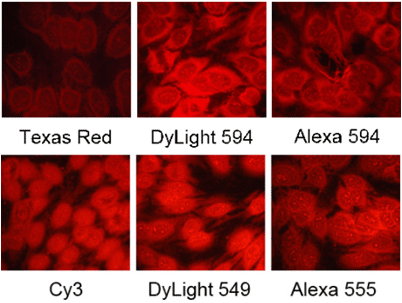 |
The DyLight 488-labeled antibody is brighter than the Cy2 and FITC markers and is comparable to the Alexa Fluor 488 marker. The DyLight 549-labeled antibody is brighter than the traditional rhodamine, TRITC, etc., and is comparable to the Cy3 and Alexa Fluor 555; the DyLight 594-labeled antibody is significantly brighter than the Alexa 594-labeled antibody. Compared to Texas Red, it is not only brighter, but also has better water solubility.
Second, DyLight fluorescent secondary antibody has a lower background than traditional fluorescent and Alexa labeled secondary antibodies!
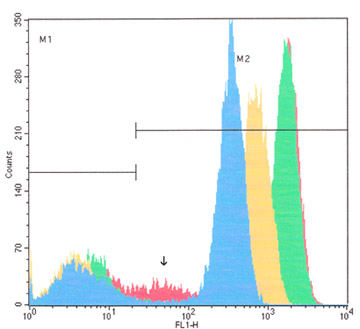 | 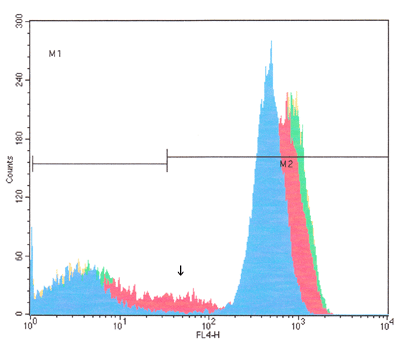 |
The top left panel depicts the analysis of anti-CD3 and other fluorescein-labeled human peripheral blood lymphocyte profiles using a FACSCalibur flow cytometer (Becton Dickinson). Different colors indicate DyLight 488 (green), FITC (yellow), Cy2 (blue), and Alexa Fluor 488 (red) labeled fluorescent secondary antibodies. The arrow indicates that Alexa Fluor 488 has a slight background in this experiment. The upper right panel is a map of human peripheral blood lymphocytes labeled with anti-CD3 and various fluorescein-linked secondary antibodies in flow cytometry. Green is DyLight 649, yellow is APC, and blue is Cy5 labeled secondary antibody. Alexa Fluor 647 is a red area. The arrow indicates that Alexa Fluor 647 has a slight background in this experiment.
Third, DyLight fluorescent secondary antibody has better optical stability than traditional fluorescent labeled secondary antibody, longer lasting light, more suitable for taking pictures
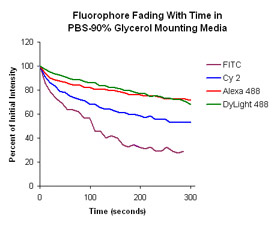 |  | 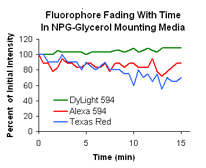 |
In terms of photostability, both DyLight 488 and Alexa 488 performed better than FITC and Cy2; DyLight 549 and Alexa 555 have comparable lightfastness and are slightly stronger than Cy3. Adding anti-quenching agents such as ProLong Gold, VECTASHIELD or N-propyl gallate-containing PBS-glycerol to the tablet can increase the lightfastness of these three fluorescent dyes; in the orange-red region of the visible spectrum, DyLight 549 and The Cy3-labeled secondary antibody showed the greatest sensitivity in all immunofluorescence experiments. DyLight 594 is much more stable than Texas Red in the absence of anti-quenching agents, comparable to Alexa594; DyLight 594 also performs well with certain anti-quenching agents.
Fourth, DyLight fluorescent secondary antibody type more and more
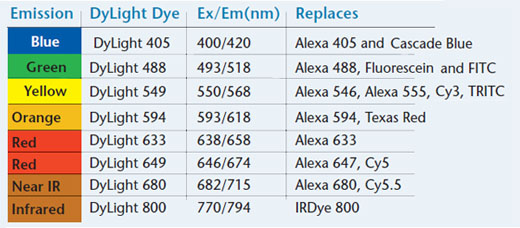 From the most commonly used fluorescent colors such as blue DyLight 405, green DyLight 488, yellow DyLight 549, orange DyLight 594 to red DyLight 633 and DyLight 649, the spectral distribution of excitation and emission is reasonable, suitable for various fluorescence analysis. The blue fluorescent DyLight 405 is suitable for three-label experiments other than green and red.
From the most commonly used fluorescent colors such as blue DyLight 405, green DyLight 488, yellow DyLight 549, orange DyLight 594 to red DyLight 633 and DyLight 649, the spectral distribution of excitation and emission is reasonable, suitable for various fluorescence analysis. The blue fluorescent DyLight 405 is suitable for three-label experiments other than green and red.
In addition, there are two far-infrared DyLight-labeled antibodies with lower fluorescence background interference and stronger sample penetration, making them more suitable for research in the field of imaging of cells or tissues. Amy Jie's imported DyLight antibody products cover a variety of animal species, including human, mouse, rabbit, rat, etc., as well as three labeled streptavidin.
Five, DyLight fluorescent secondary antibody has the highest cost performance!
One problem that may need to be considered is the price issue. In fact, Dylight's fluorescent secondary antibody has a higher cost performance than conventional fluorescent secondary antibodies. In general, Dylight is only about 20% more expensive than conventional secondary antibodies, but Dylight's potency is usually about 2-4 times that of conventional fluorescent secondary antibodies, so Dylight is better than the final price/performance ratio. For example, Abbkine's FITC-labeled goat anti-mouse IgG secondary antibody (Cat. No. A22110), 100 μl is ¥160; and the corresponding Abbkine Dylight 488-labeled goat anti-mouse IgG secondary antibody (Cat. No. A23210), 100 μl The quotation is ¥240, but in specific use, such as immunofluorescence experiments, the recommended dilution ratio is 1:100 and 1:400, ie 100μl of FITC-labeled goat anti-mouse IgG secondary antibody (Cat. No. A22110) final use solution It is 10ml, and 100μl of Dylight 488-labeled goat anti-mouse IgG secondary antibody (Cat. No. A23210) is 40ml, which is visible even without considering the higher fluorescence intensity, better optical stability and specificity of Dylight. In terms of price, Dylight fluorescent secondary antibody also has a higher cost performance.
We recommend the DyLight fluorescent series secondary antibody products in the small liquid packaging of Abbkine imported from the United States, as well as the full range of DyLight secondary antibodies in various specifications of Immunoreagents and Jackson.
 A small package of Abbkine's DyLight fluorescent secondary antibody. Both 100μl and 500μl are available in stock. Abbkine is a US company specializing in the production of immunological reagents and providing cytology research solutions. Its products are mainly exported to universities, research institutes and other research institutions around the world. Abbkine offers you the most commonly used DyLight 549 fluorescently labeled secondary antibody products:
A small package of Abbkine's DyLight fluorescent secondary antibody. Both 100μl and 500μl are available in stock. Abbkine is a US company specializing in the production of immunological reagents and providing cytology research solutions. Its products are mainly exported to universities, research institutes and other research institutions around the world. Abbkine offers you the most commonly used DyLight 549 fluorescently labeled secondary antibody products:
Antibody Description Item Number | Fluorescent Label | DyLight 405 400nm/421nm | DyLight 488 493nm/518nm | DyLight 549 555nm/568nm | DyLight 594 591nm/616nm | DyLight 649 652nm/670nm |
Goat Anti-Mouse IgG (H+L) | A23110 | A23210 | A23310 | A23410 | A23610 |
Goat Anti-Rabbit IgG (H+L) | A23120 | A23220 | A23320 | A23420 | A23620 |
Rabbit Anti-Goat IgG (H+L) | A23130 | A23230 | A23330 | A23430 | A23630 |
Goat Anti-Rat IgG (H+L) | A23140 | A23240 | A23340 | A23440 | A23640 |
Goat Anti-Human IgG (H+L) | A23150 | A23250 | A23350 | A23450 | A23650 |
Note: Each specification is available in 100μl and 500μl. The 2013 quotations are ¥240/¥960 respectively. For the latest quotation, please use the item number to check the website. | |||||
Large packaging DyLight secondary antibody is more cost-effective and more!
 Since the DyLight fluorescent secondary antibody itself has a small molecular weight, more DyLight fluorescent substances can be labeled on the same secondary antibody molecule , for example, compared with the same specification of FITC goat anti-mouse secondary antibody ( Cat . No. 115-095-003 ). Although the increase is 25% , the titer is 100% higher ! This has not considered DyLight's better resistance to catastrophe, sensitivity and signal to noise ratio!
Since the DyLight fluorescent secondary antibody itself has a small molecular weight, more DyLight fluorescent substances can be labeled on the same secondary antibody molecule , for example, compared with the same specification of FITC goat anti-mouse secondary antibody ( Cat . No. 115-095-003 ). Although the increase is 25% , the titer is 100% higher ! This has not considered DyLight's better resistance to catastrophe, sensitivity and signal to noise ratio! 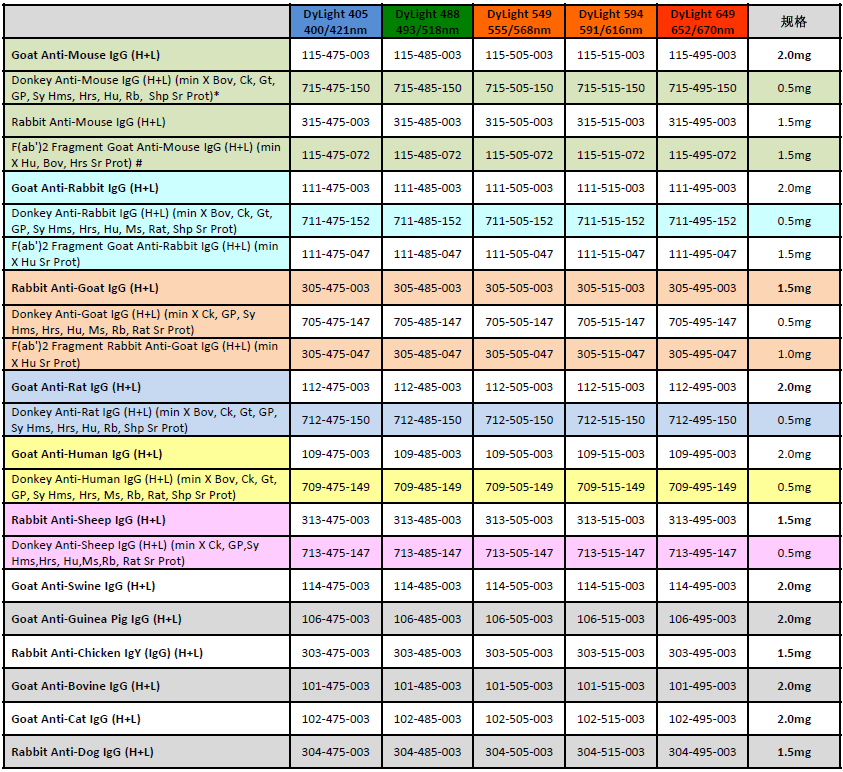
* labeled " (min X...Prot)" Â The typefaced antibody is a secondary antibody that has been subjected to adsorption treatment of IgG and / or serum proteins of the species indicated in parentheses . Secondary antibodies that react with one species may cross-react with other species unless such antibodies are subjected to absorption experiments by other species. The adsorption of serum proteins by related species can reduce the non-specific binding ability to IgG of this species . However, it should be noted that the number of epitopes recognized by antibodies against species adsorption for similar species of monoclonal antibodies is also reduced, and their ability to recognize monoclonal antibodies is also weak.
# Â This secondary antibody in the form of the F( ab ')2 fragment is a pepsin-digested IgG- removed Fc portion, leaving two disulfide-linked Fab portions that bind to the antigen , still bivalent; the antibody can be avoided Protein A /G or its binding to Fc receptors is also more sensitive because it is better in itself and more easily penetrates into the cellular tissue structure.
For more DyLight product applications, technical support and product inquiries, please contact Ai Meijie Technology Co., Ltd. If you are interested in the above products, please call the national free electric relay 801/802/803 or 027-84454412/4876 to contact Ai Meijie Technology Co., Ltd. for related product information and complete experimental solutions.
Ningbo DOKEE Medical Technology Co., Ltd. , https://www.dokeemedical.com